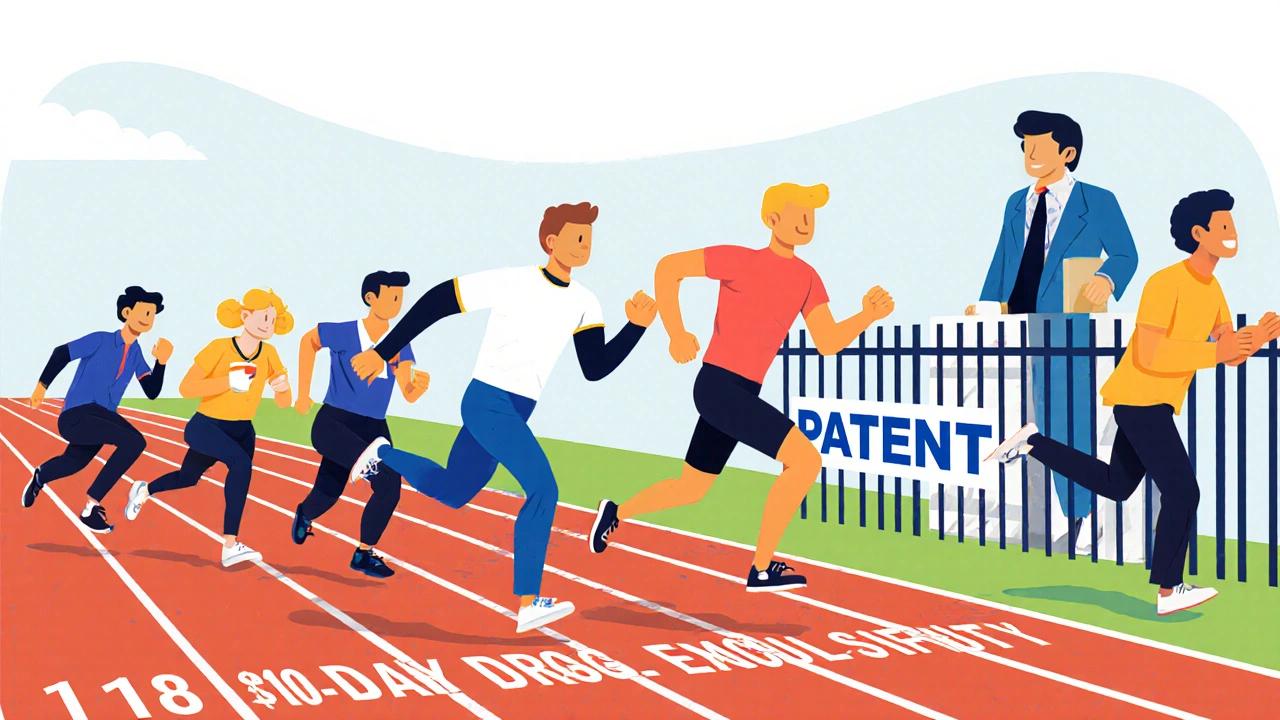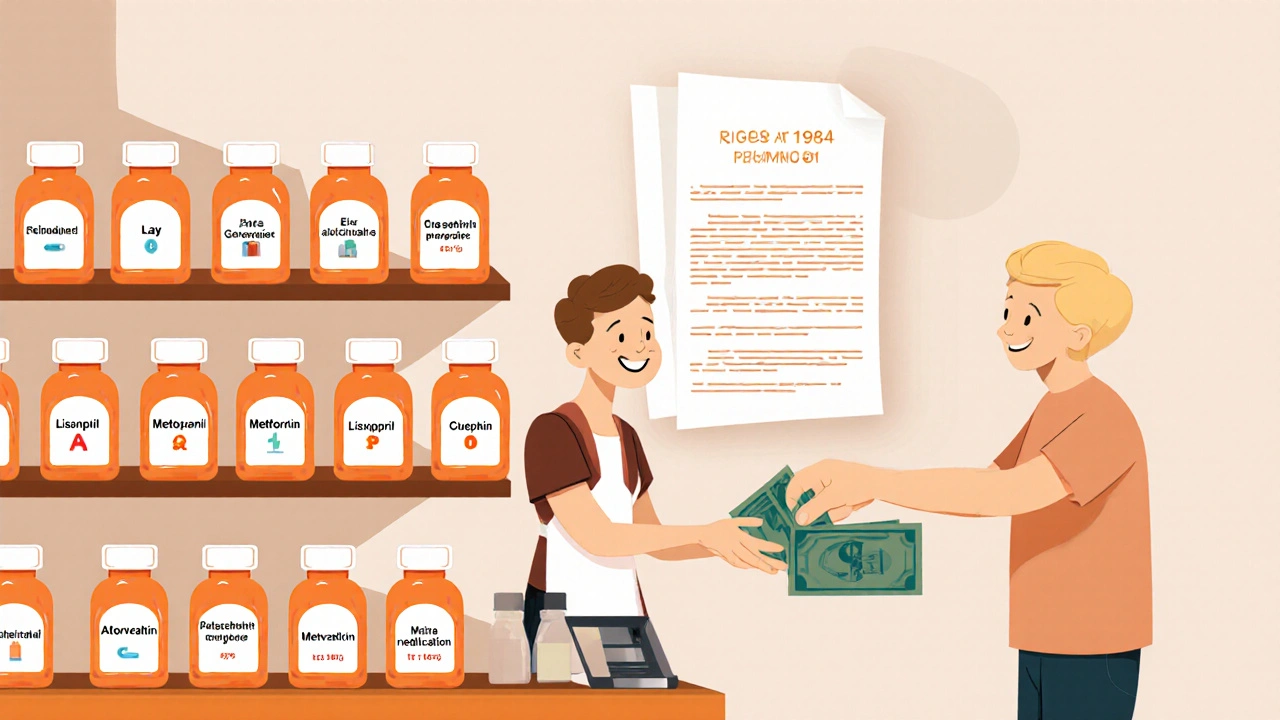Hatch-Waxman Amendments: How Landmark Law Made Generic Drugs Possible
 Nov, 22 2025
Nov, 22 2025
The U.S. generic drug market didn’t just happen. Before 1984, if you needed a cheaper version of a brand-name medicine, you were out of luck. Most generics didn’t exist-not because no one wanted to make them, but because the law made it nearly impossible. The Hatch-Waxman Amendments changed all that. Passed on September 24, 1984, this law didn’t just tweak the system-it rebuilt it from the ground up. It created a path for affordable drugs to reach millions while still giving innovators a fair shot at recouping their research costs. Today, nearly 90% of prescriptions filled in the U.S. are for generics. That’s not an accident. It’s the direct result of this one piece of legislation.
What Was the Problem Before Hatch-Waxman?
Before the Hatch-Waxman Act, generic drug makers had to prove a drug was safe and effective all over again. Even if the active ingredient was identical to the brand-name version, they had to run full clinical trials. That meant spending millions and waiting years just to get approval. Meanwhile, brand-name companies held patents that blocked anyone else from even testing their drugs until the patent expired. A 1984 court case, Roche v. Bolar, made it clear: if you started testing a generic version before the patent ran out, you were breaking the law-even if you weren’t selling it yet. That gave brand-name companies an extra years-long monopoly, long after their patent should have expired. The result? Fewer generics. Higher prices. Less access.The Two-Sided Solution
The Hatch-Waxman Act didn’t favor one side over the other. It tried to balance two competing needs: helping patients get cheaper drugs, and keeping pharmaceutical companies motivated to invent new ones. It did that with two major tools. First, it created the Abbreviated New Drug Application (ANDA). This let generic manufacturers skip the expensive, time-consuming clinical trials. Instead, they only had to prove their drug was bioequivalent to the brand-name version-meaning it worked the same way in the body. That cut development costs by 80 to 90%. Suddenly, making a generic wasn’t a financial gamble. It was a smart business move. Second, it gave brand-name companies a way to make up for lost patent time. The FDA’s review process could take years. That ate into the 20-year patent clock. So Hatch-Waxman allowed patent extensions of up to five years-enough to make up for delays in approval. It also added extra market exclusivity periods: five years for brand-new chemical compounds, three years for new uses or formulations, and seven years for orphan drugs. These weren’t rewards for laziness-they were incentives to keep innovating.The Patent Game: Paragraph IV and the 180-Day Prize
One of the most clever parts of Hatch-Waxman was how it handled patents. Brand-name companies had to list all their patents on the FDA’s Orange Book. When a generic company filed an ANDA, they had to say how they were dealing with those patents. There were four options, but only one really changed the game: Paragraph IV certification. This was a legal challenge. It meant the generic maker believed the patent was invalid or didn’t apply to their product. If they filed it, the brand-name company had 45 days to sue them for infringement. If they did, the FDA couldn’t approve the generic for 30 months-unless the court ruled faster. That gave brand-name companies time to defend their patents. But here’s the twist: the first generic company to file a Paragraph IV certification got 180 days of exclusive market rights. No other generic could enter during that time. That 180-day window became a gold rush. Companies raced to be first. Some filed applications the moment a patent expired. Others waited until the last possible second. The FDA even had to step in and say: if two companies file on the same day, they share the exclusivity. The prize was huge-first filers could charge high prices for months before competitors showed up. That drove innovation in legal strategy as much as in drug development.
The Safe Harbor: Why Generic Companies Could Start Early
Before Hatch-Waxman, even preparing for a generic launch was risky. What if you started testing a drug six months before the patent expired? You could get sued. The Act fixed that with a simple rule: activities done “reasonably related to the development and submission of information” to the FDA were exempt from patent infringement. This became known as the safe harbor provision (35 U.S.C. § 271(e)(1)). That single line changed everything. Generic companies could now start manufacturing, testing, and packaging their versions years before the patent expired. They could build supply chains, train staff, and get regulatory documents ready. When the patent finally fell, they were ready to go. No delays. No waiting. That’s why today, you can walk into a pharmacy and find a generic version of almost any drug-often within days of the brand-name patent expiring.The Numbers Don’t Lie
The impact of Hatch-Waxman is measurable. In 1983, generics made up less than 19% of prescriptions in the U.S. By 2023, that number was 90%. The FDA says over 10,000 generic products are now available. And they cost 80 to 85% less than their brand-name equivalents. That’s not just savings-it’s access. A diabetic patient can now afford insulin. A heart patient can take their blood pressure pill every day. A parent can fill their child’s antibiotic prescription without choosing between medicine and groceries. The Congressional Research Service estimates the Act saved U.S. consumers more than $300 billion in the first decade alone. By 2024, that number was over $3 trillion. That’s not a guess. That’s the cost of every generic prescription filled since 1984.
What Went Wrong?
But Hatch-Waxman wasn’t perfect. The system was designed to balance interests. Over time, some players found ways to tilt the scales. One big problem: pay-for-delay. Sometimes, brand-name companies would pay generic manufacturers to delay launching their cheaper version. Instead of fighting in court, they cut a deal: we’ll give you millions, you stay off the market. The Federal Trade Commission found 668 of these deals between 1999 and 2012. They estimated those deals cost consumers $35 billion a year in higher prices. Another tactic: evergreening. Brand-name companies would make tiny changes to their drugs-a new coating, a different dose-and file new patents. Then they’d use those to block generics, even when the original patent expired. The FDA had to fight back with rules that limited what counted as a new patentable feature. Then there’s the citizen petition loophole. Companies could file petitions with the FDA claiming safety or efficacy issues with a generic drug-even if those claims were baseless. The FDA had to respond, and that could delay approval for months. Some petitions were clearly meant to stall, not protect patients.Has the Balance Shifted?
The original compromise was elegant. Generics get a fast, cheap path to market. Innovators get extra time to profit. But today, the system feels uneven. The 180-day exclusivity period still creates chaos. The safe harbor is still used to jump-start development. And patent litigation is more complex than ever. In 2023, Congress introduced the Preserve Access to Affordable Generics and Biosimilars Act to crack down on pay-for-delay deals. The FDA has also improved its review process. Under the Generic Drug User Fee Amendments (GDUFA), the average review time for an ANDA dropped from 30 months in 2012 to under 12 months by 2022. Still, critics argue the system favors big pharma. Brand-name companies now spend more on legal teams than on research. The cost of innovation is rising. And for patients, the price of some drugs hasn’t dropped at all-even when generics are available.Why It Still Matters
Hatch-Waxman didn’t just change drug policy. It changed lives. It turned the idea of affordable medicine from a dream into a reality. It gave patients choice. It gave pharmacies reliable supply. It gave insurers lower costs. The law didn’t solve every problem. But it created a working system where none existed before. Today, when you pick up a bottle of generic lisinopril for $4, you’re seeing the result of a 40-year-old compromise between two powerful industries. It wasn’t perfect. But it was necessary. And it still works-when it’s not being gamed.As new drugs, biosimilars, and complex biologics enter the market, the questions are the same: How do we keep innovation alive? How do we make sure no one is priced out of life-saving medicine? Hatch-Waxman didn’t have all the answers in 1984. But it gave us the framework to keep asking them.

Abhay Chitnis
November 24, 2025 AT 06:58Robert Spiece
November 25, 2025 AT 15:01Vivian Quinones
November 26, 2025 AT 10:50Eric Pelletier
November 28, 2025 AT 07:01Marshall Pope
November 29, 2025 AT 08:05Nonie Rebollido
November 29, 2025 AT 18:31Agha Nugraha
December 1, 2025 AT 03:24Andy Smith
December 2, 2025 AT 02:48Rekha Tiwari
December 2, 2025 AT 12:36Leah Beazy
December 3, 2025 AT 23:02John Villamayor
December 4, 2025 AT 18:55Jenna Hobbs
December 5, 2025 AT 11:35Ophelia Q
December 6, 2025 AT 20:42Elliott Jackson
December 6, 2025 AT 23:12McKayla Carda
December 8, 2025 AT 18:28